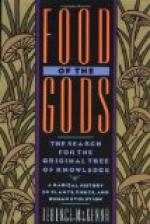Here are grazing donkeys, mules, and cattle, while the chickens run under the shrubs for shelter, reminding one of home. The house is surrounded with crotons and other brilliant plants, beyond which is a rose garden, the special pride of the planter’s wife. If the sun has gone down behind the western hills, the boys will come out and play cricket in the hour before sunset. These savannas are the beauty-spots of a country clothed in woodland from sea-shore to mountain-top.
[Illustration—Black and White Plate: Ortinola, Maracas, Trinidad.]
Next morning we are awaked by a blast from a conch-shell. It is 6.30, and the mist still clings in the valley; the sun will not be over the hills for another hour or more, so in the cool we join the labourers on the mule-track to the higher land, and for a mile or more follow a stream into the heart of the estate. If it is crop-time, the men will carry a goulet—a hand of steel, mounted on a long bamboo—by the sharp edges of which the pods are cut from the higher branches without injury to the tree. Men and women all carry cutlasses, the one instrument needful for all work on the estate, serving not only for reaping the lower pods, but for pruning and weeding, or “cutlassing,” as the process of clearing away the weed and brush is called.
[Illustration—Drawing: GOULET AND WOODEN SPOON.]
[Illustration—Drawing: CUTLASSES.]
Gathering the pods is heavy work, always undertaken by men. The pods are collected from beneath the trees and taken to a convenient heap, if possible near to a running stream, where the workers can refill their drinking-cups for the mid-day meal. Here women sit, with trays formed of the broad banana leaves, on which the beans are placed as they extract them from the pod with wooden spoons. The result of the day’s work, placed in panniers on donkey-back, is “crooked” down to the cocoa-house, and that night remains in box-like bins, with perforated sides and bottom, covered in with banana leaves. Every twenty-four hours these bins are emptied into others, so that the contents are thoroughly mixed, the process being continued for four days or more, according to circumstances.
This is known as “sweating.” Day by day the pulp becomes darker, as fermentation sets in, and the temperature is raised to about 140 deg. F. During fermentation a dark sour liquid runs away from the sweat-boxes, which is, in fact, a very dilute acetic acid, but of no commercial value. During the process of “sweating” the cotyledons of the cocoa-bean, which are at first a purple colour and very compact in the skin, lose their brightness for a duller brown, and expand the skin, giving the bean a fuller shape. When dry, a properly cured bean should crush between the finger and thumb.
[Illustration—Black and White Plate: Cacao Drying in the Sun, Maracas, Trinidad.]




